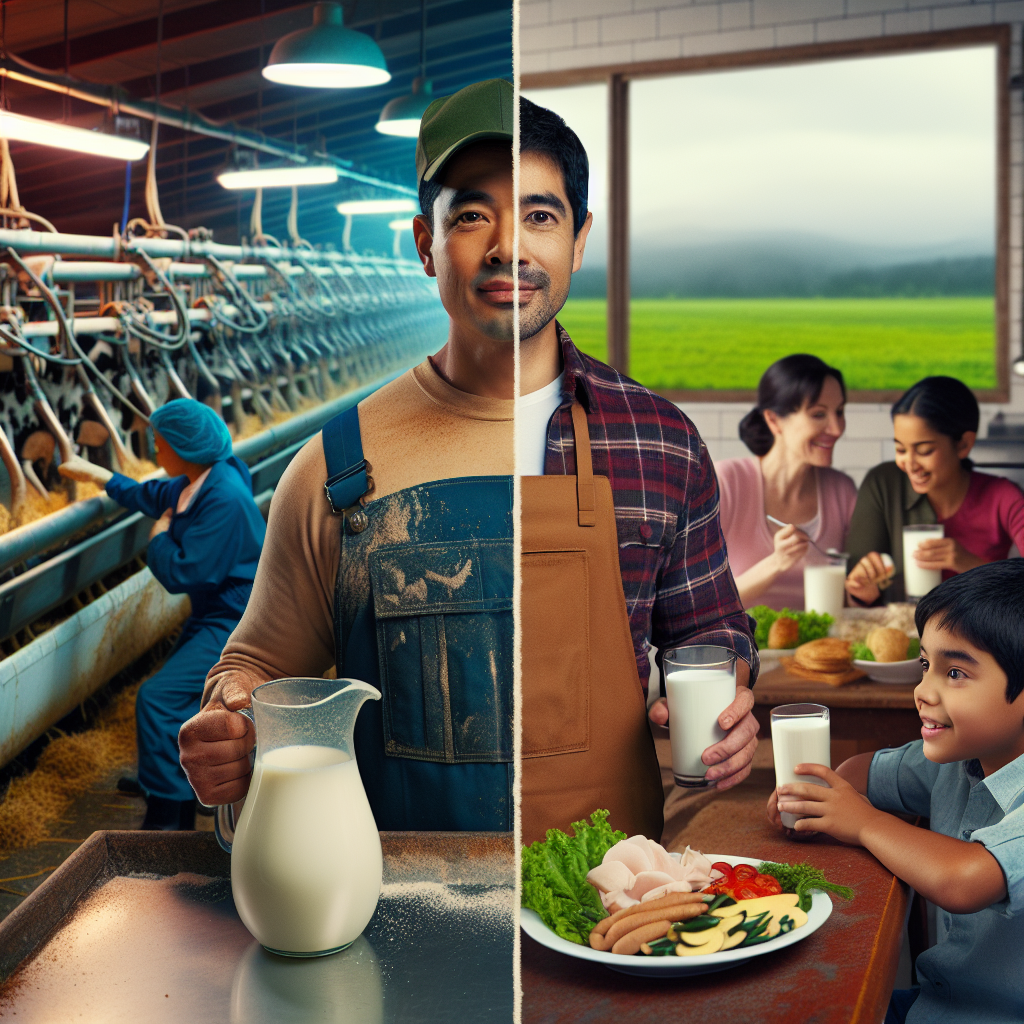Learn how changing consumer preferences are shaping dairy farming. Ready to explore the future of sustainable and ethical dairy?

Consumer tastes are constantly changing, necessitating quick reactions. The dairy sector has evolved beyond providing milk to include essential problems such as product diversification and ethical ethics. Those who accept these changes will succeed, while those who do not risk falling behind will fail. Modern customers want sustainability, animal welfare, product diversity, and the incorporation of new technology. Approximately 55% of US consumers said they would buy more dairy products if producers promoted sustainability. The future of dairy farming depends on accepting these adaptive methods. Staying ahead of changing consumer tastes promotes sustainability and helps to create a more ethical and resilient food system.
Embracing Solid and Semi-Solid Dairy: A Necessity for Modern Dairy Farming
Regarding consumer preferences, dairy customers prefer solid or semi-solid products over typical liquid milk. This trend includes liking cheese, butter, yogurt, and sour cream, indicating a changing taste that values variety and creativity. Furthermore, a rising portion demands lactose-friendly versions to cater to those who are lactose intolerant or sensitive. Moreover, the popularity of plant-based dairy substitutes such as oats, almonds, and soy-based products has expanded the market. These alternatives appeal to vegetarians, people with dietary limitations, and mainstream customers seeking to lessen their environmental impact or try new tastes. For dairy producers, expanding their product lines is critical. Changes in dietary choices underscore the need for innovation and adaptability to stay competitive and profitable. Farmers may extend their variety to include more eatable dairy products and lactose-friendly alternatives, allowing them to enter new markets and increase economic resilience. This move has significant repercussions for the dairy farming business. Farmers must manage new production problems and invest in new processing technology to fulfill rising demand. However, the benefits are substantial: reacting proactively to consumer trends may open new income streams, alleviate diminishing conventional milk consumption concerns, and position farmers to succeed in a changing market.
Sustainability: A Driving Force for Consumer Loyalty and Market Success
Consumers’ increased concern about sustainability strongly influences their shopping choices. This understanding drives dairy producers to pursue sustainable techniques actively. Consumers increasingly prioritize items from firms that value environmental stewardship and ethical behaviors, demonstrating a clear correlation between sustainability activities and commercial success.
Promoting sustainability in dairy production requires various critical components, including improved animal welfare and modern technology. Better animal care, including optimal living conditions and nutrition, produces higher-quality dairy products. Sustainable practices such as rotational grazing, organic feeding, and prudent manure management promote environmental health while conserving resources.
Adopting new technology may provide significant environmental benefits. Precision agricultural equipment, robots, and data-driven systems allow for more efficient resource usage, less waste, and increased yield. Automated milking systems may improve cow health and comfort while increasing milk output.
As part of the transition to sustainability, dairy producers must rethink established practices and invest in innovative techniques and technology that meet customer expectations. While these adjustments may require a significant initial expenditure, the long-term rewards include improved market position, increased customer loyalty, and enhanced profitability. Finally, by adopting sustainability, dairy producers may ensure their enterprises’ resilience and longevity while contributing to a more ethical and ecologically conscientious food chain.
Consumer-Driven Animal Welfare: The New Benchmark for Dairy Farming Practices
Consumer concern for animal welfare has reached new heights, directly impacting purchase decisions. This growing awareness is more than just a moral attitude; it influences dairy product purchases, making animal welfare a crucial commercial dynamic. Dairy producers must prioritize health, welfare, and longevity in their breeding programs to gain customer loyalty and confidence. This shift towards consumer-driven animal welfare is not just a trend, but a responsibility that the dairy industry must embrace to ensure the ethical integrity of its operations.
Painless dehorning is popular among customers since it eliminates hardship and matches farming with humane norms. Similarly, restricting antibiotic usage to therapeutic illness applications reduces antibiotic resistance, protecting both animal welfare and public health. Certifications such as “Certified Humane®” reinforce a reputation for ethical farming.
These changes in practice are more than just meeting consumer wants; they represent steps toward a more resilient and sustainable agricultural strategy. Prioritizing animal welfare leads to healthier, more productive cattle, which improves farm efficiency. Furthermore, progressive welfare measures may open premium market sectors, resulting in better returns and longer-term sustainability. Thus, addressing consumer expectations for animal care meshes with ethical imperatives while improving the dairy industry’s sustainability and profitability.
Integrating Biotechnology with Consumer Expectations: A Strategic Balance
New technologies, including gene editing, can improve animal health and production in dairy farming. These improvements could enhance disease resistance, nutritional quality, and milk production, boosting dairy farms’ sustainability and profitability.
For example, gene editing may make cattle less disease-prone, lowering antibiotic consumption and coinciding with rising customer demand for low-antibiotic food. However, many customers remain wary of GMOs and prefer humane agricultural techniques. As a result, openness and regulation are critical for building customer confidence. Labels such as “Non-GMO” and certificates for humane practices give customers the confidence they desire.
Farmers’ impressions of consumer support are crucial. If they feel that customers can be trained to support these advances, they are more inclined to implement them. In contrast, perceived opposition might stymie acceptance. Thus, good communication and education regarding advantages and safety are critical for increasing customer adoption.
For dairy producers, reconciling cutting-edge technology with customer expectations is critical. Responsible innovation promotes healthier herds and more sustainable agricultural techniques. Transparency and regard for customer views, as expressed through feedback and market trends, will boost productivity and foster trust, assuring long-term market acceptability and corporate survival.
Transparency and Connection: Building Trust and Loyalty in the Dairy Industry
The modern consumer environment demands transparency and a real connection to their food source. This needs reinvented food supply networks, including more segmentation and direct contact between farmers and consumers. The growing interest in farm management labels such as “Non-GMO” and “Certified Humane®” indicates a cultural movement toward educated and ethical consumption.
Dairy producers face both difficulties and opportunities. Adapting to these expectations requires substantial expenditures in openness and certification. However, it also allows for higher prices and improved customer loyalty. Direct marketing is promising because it will enable farmers to sell their goods directly—via farmers’ markets, internet platforms, or local partnerships—thereby increasing value and distinction.
This trend of openness and direct interaction has far-reaching ramifications for the dairy industry’s sustainability and resilience. Farmers receive insights into changing customer tastes and market trends by developing tighter relationships with them, allowing for more adaptable business methods. Finally, aligning with these consumer-driven imperatives not only increases market relevance but also ensures the long-term sustainability and ethical integrity of dairy farming operations by building trust and loyalty.
The Bottom Line
In an age of shifting customer expectations, dairy producers must adapt to a demanding market by focusing on product diversity, sustainability, animal welfare, and the incorporation of innovative technology. The transition to solid and semi-solid dairy products necessitates diversification. The demand for sustainable and environmentally friendly goods highlights the need for green procedures. At the same time, increased awareness about animal welfare promotes a rethinking of established approaches. Technology adoption should strike a balance between innovation and ethical issues. Aligning with changing tastes is crucial for long-term profitability and sustainability, allowing farmers to remain relevant and contribute to a more ethical food system. The message is clear: accept change, innovate, and match practices with current consumer ideals.
Key Takeaways:
- Dairy farmers must adapt to the growing consumer demand for solid and semi-solid dairy products like cheese, yogurt, and lactose-friendly options.
- Sustainability is a crucial factor in consumer purchasing decisions, encouraging farms to adopt eco-friendly and animal-friendly practices.
- Consumers prioritize animal welfare, pushing farmers to focus on health, welfare, and humane treatment in their breeding and care practices.
- New technologies, including genetic biotechnologies, are becoming integral to dairy farming, but must be balanced with consumer preferences for non-GMO and humane practices.
- Transparency and direct consumer engagement are essential for building trust, with labels such as “Non-GMO” and “Certified Humane®” enhancing product appeal.
Summary:
The dairy sector is facing a shift in consumer preferences due to evolving consumer tastes. Modern customers demand sustainability, animal welfare, product diversity, and new technology. Around 55% of US consumers would buy more dairy products if producers promoted sustainability. Dairy customers prefer solid or semi-solid products over liquid milk, and a growing portion demands lactose-friendly versions. Plant-based dairy substitutes are also popular, appealing to vegetarians and dietary restrictions. Dairy producers must expand their product lines to stay competitive and profitable, including more eatable dairy products and lactose-friendly alternatives. Prioritizing animal welfare in breeding programs is crucial for customer loyalty and confidence. Farmers’ support, communication, and education about benefits and safety are essential for increasing customer adoption.












